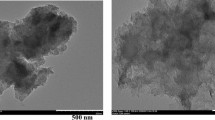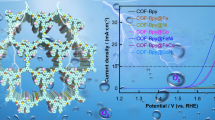Abstract
Effectively facilitating Fe3+/Fe2+ cycles and expanding its operating pH range are keys to optimizing the traditional Fenton reaction. In this exploration, we used chitosan and ferrous sulfate as precursors to prepare a multicomponent magnetic Fe/C Fenton-like catalyst, which exhibited extraordinary catalytic properties and excellent stability performance in a pH range of 4~8. Besides, it could be easily separated from the solution by a magnet. The characterization showed that the supported Fe species include troilite-2H (FeS), lepidocrocite (FeOOH), and pyrrhotite-6T (Fe1 − xS) with a unique “core-shell structure.” The presence of reductive iron sulfide core in the system can accelerate the reduction of Fe(III). Meanwhile, the graphite-like structure formed after calcination can adsorb and enrich priority pollutants near the active site through π–π coupling and strengthen electron transfer, which endows its high catalytic performance and enables it invulnerable to dissolved organic compounds.










Similar content being viewed by others
Data availability
All data included in this study are available upon request by contact with the corresponding author.
References
Blandez JF, Primo A, Asiri AM, Alvaro M, Garcia H (2014) Copper nanoparticles supported on doped graphenes as catalyst for the dehydrogenative coupling of silanes and alcohols. Angew Chem Int Ed Engl 53(46):12581–12586. https://doi.org/10.1002/anie.201405669
Bolobajev J, Trapido M, Goi A (2015) Improvement in iron activation ability of alachlor Fenton-like oxidation by ascorbic acid. Chem Eng J 281:566–574. https://doi.org/10.1016/j.cej.2015.06.115
Chen H, Zhang Z, Yang Z, Yang Q, Li B, Bai Z (2015) Heterogeneous Fenton-like catalytic degradation of 2,4-dichlorophenoxyacetic acid in water with FeS. Chem Eng J 273:481–489. https://doi.org/10.1016/j.cej.2015.03.079
Chu C, Yang J, Huang D, Li J, Wang A, Alvarez PJJ, Kim JH (2019) Cooperative pollutant adsorption and persulfate-driven oxidation on hierarchically ordered porous carbon. Environ Sci Technol 53(17):10352–10360. https://doi.org/10.1021/acs.est.9b03067
Chung MW, Choi CH (2017) Carbon nanofibers as parent materials for a graphene-based Fe-N-C catalyst for the oxygen reduction reaction. Catal Today 295:125–131. https://doi.org/10.1016/j.cattod.2017.05.020
Dhakshinamoorthy A, Primo A, Concepcion P, Alvaro M, Garcia H (2013) Doped graphene as a metal-free carbocatalyst for the selective aerobic oxidation of benzylic hydrocarbons, cyclooctane and styrene. Chem. Eur. J 19(23):7547–7554. https://doi.org/10.1002/chem.201300653
Dong C, Ji J, Shen B, Xing M, Zhang J (2018) Enhancement of H2O2 decomposition by the co-catalytic effect of WS3 on the Fenton reaction for the synchronous reduction of Cr(VI) and remediation of phenol. Environ Sci Technol 52(19):11297–11308. https://doi.org/10.1021/acs.est.8b02403
Ferrandon M, Kropf AJ, Myers DJ, Artyushkova K, Kramm U, Bogdanoff P, Wu G, Johnston CM, Zelenay P (2012) Multitechnique characterization of a polyaniline–iron–carbon oxygen reduction catalyst. J Phys Chem C 116(30):16001–16013. https://doi.org/10.1021/jp302396g
Fromm O, Heckmann A, Rodehorst UC, Frerichs J, Becker D, Winter M, Placke T (2018) Carbons from biomass precursors as anode materials for lithium ion batteries: new insights into carbonization and graphitization behavior and into their correlation to electrochemical performance. Carbon 128:147–163. https://doi.org/10.1016/j.carbon.2017.11.065
Gao P, Song Y, Hao M, Zhu A, Yang H, Yang S (2018) An effective and magnetic Fe2O3-ZrO2 catalyst for phenol degradation under neutral pH in the heterogeneous Fenton-like reaction. Sep Purif Technol 201:238–243. https://doi.org/10.1016/j.seppur.2018.03.017
Han W, Li C, Jiang Y, Ma Z, Zhang Y, Yan X, Zheng X (2021) Atomically-dispersed Fe-Nx and C–S–C ordered mesoporous carbons as efficient catalysts for the oxygen reduction reaction in a microbial fuel cell. J Alloy Compd 156994. https://doi.org/10.1016/j.jallcom.2020.156994
He J, Miller CJ, Collins R, Wang D, Waite TD (2020) Production of a surface-localized oxidant during oxygenation of mackinawite (FeS). Environ Sci Technol 54(2):1167–1176. https://doi.org/10.1021/acs.est.9b03975
Hou X, Huang X, Jia F, Ai Z, Zhao J, Zhang L (2017) Hydroxylamine promoted goethite surface Fenton degradation of organic pollutants. Environ Sci Technol 51(9):5118–5126. https://doi.org/10.1021/acs.est.6b05906
Kallel M, Belaid C, Boussahel R, Ksibi M, Montiel A, Elleuch B (2009) Olive mill wastewater degradation by Fenton oxidation with zero-valent iron and hydrogen peroxide. J Hazard Mater 163(2-3):550–554. https://doi.org/10.1016/j.jhazmat.2008.07.006
Kan X, Zhang G, Luo Y, Liu F, Zheng Y, Xiao Y, Cao Y, Au C-t, Liang S, Jiang L (2020) Efficient catalytic removal of COS and H2S over graphitized 2D micro-meso-macroporous carbons endowed with ample nitrogen sites synthesized via mechanochemical carbonization. Green Energy & Environ. https://doi.org/10.1016/j.gee.2020.12.016
Latorre-Sanchez M, Primo A, Garcia H (2013) P-doped graphene obtained by pyrolysis of modified alginate as a photocatalyst for hydrogen generation from water-methanol mixtures. Angew Chem Int Ed Engl 52(45):11813–11816. https://doi.org/10.1002/anie.201304505
Lee Y, Zhang H, Yu HY, Tam KC (2022) Electroconductive cellulose nanocrystals - synthesis, properties and applications: a review. Carbohydr Polym 289:119419. https://doi.org/10.1016/j.carbpol.2022.119419
Li X, Liu W, Ma J, Wen Y, Wu Z (2015) High catalytic activity of magnetic FeOx/NiOy/SBA-15: the role of Ni in the bimetallic oxides at the nanometer level. Appl Catal B-Environ 179:239–248. https://doi.org/10.1016/j.apcatb.2015.05.034
Li X, Huang X, Xi S, Miao S, Ding J, Cai W, Liu S, Yang X, Yang H, Gao J, Wang J, Huang Y, Zhang T, Liu B (2018) Single cobalt atoms anchored on porous N-doped graphene with dual reaction sites for efficient Fenton-like catalysis. J Am Chem Soc 140(39):12469–12475. https://doi.org/10.1021/jacs.8b05992
Li J, Zhao J, Li B, Bu H, Yin W, Lv S, Wu J (2022) Effective inactivation of Escherichia coli in aqueous solution by activated carbon-supported α-FeOOH as heterogeneous Fenton catalyst with high stability and reusability. J Environ Eng 107347. https://doi.org/10.1016/j.jece.2022.107347
Lu H, Wang C, Liu X, Zhang J, Lin Z, Hao Z, Pan G (2021) PH-dependent photochemical transformation of arsenic sulfide sludge catalyzed by Fe ions under visible light irradiation. Appl Catal B-Environ 293:120186. https://doi.org/10.1016/j.apcatb.2021.120186
Ma J, Zhou B, Zhang H, Zhang W (2020) Fe/S modified sludge-based biochar for tetracycline removal from water. Powder Technol 364:889–900. https://doi.org/10.1016/j.powtec.2019.10.107
Nieto-Juarez JI, Pierzchla K, Sienkiewicz A, Kohn T (2010) Inactivation of MS2 coliphage in Fenton and Fenton-like systems: role of transition metals, hydrogen peroxide and sunlight. Environ Sci Technol 44(9):3351–3356. https://doi.org/10.1021/es903739f
Pan Y, Su H, Zhu Y, Vafaei Molamahmood H, Long M (2018) CaO2 based Fenton-like reaction at neutral pH: accelerated reduction of ferric species and production of superoxide radicals. Water Res 145:731–740. https://doi.org/10.1016/j.watres.2018.09.020
Pang SY, Jiang J, Ma J (2011) Oxidation of sulfoxides and arsenic(III) in corrosion of nanoscale zero valent iron by oxygen: evidence against ferryl ions (Fe(IV)) as active intermediates in Fenton reaction. Environ Sci Technol 45(1):307–312. https://doi.org/10.1021/es102401d
Rezaei F, Vione D (2018) Effect of pH on zero valent iron performance in heterogeneous Fenton and Fenton-like processes: a review. Molecules 23:3127. https://doi.org/10.3390/moleculeS33123127
Shende TP, Bhanvase BA, Rathod AP, Pinjari DV, Sonawane SH (2018) Sonochemical synthesis of graphene-Ce-TiO2 and graphene-Fe-TiO2 ternary hybrid photocatalyst nanocomposite and its application in degradation of crystal violet dye. Ultrason Sonochem 41:582–589. https://doi.org/10.1016/j.ultsonch.2017.10.024
Sun X, Qi H, Mao S, Sun Z (2021) Atrazine removal by peroxymonosulfate activated with magnetic CoFe alloy@N-doped graphitic carbon encapsulated in chitosan carbonized microspheres. Chem Eng J 130169. https://doi.org/10.1016/j.cej.2021.130169
Wang J, Tang J (2021) Fe-based Fenton-like catalysts for water treatment: catalytic mechanisms and applications. J Mol Liq 332:115755. https://doi.org/10.1016/j.molliq.2021.115755
Wang N, Zheng T, Zhang G, Wang P (2016) A review on Fenton-like processes for organic wastewater treatment. Chem Eng J 4:762–787. https://doi.org/10.1016/j.jece.2015.12.016
Wang C, Ying C, Tang Y, Yan Y, Feng X (2020) Synergistic effect of Co(II) doping on FeS activating heterogeneous Fenton processes toward degradation of rhodamine B. Chem Eng J-Advan 100044. https://doi.org/10.1016/j.ceja.2020.100044
Yang Q, Jia N, Shen C, Ma J, Wen Y (2018) Activation of peroxymonosulfate by Fe-N complexes embedded within SBA-15 for removal of organic contaminants via production of singlet oxygen. Environ Sci Pollut Res Int 25:34190–34199. https://doi.org/10.1007/S21356-018-3323-1
Yang Y, Xu L, Wang J (2021) An enhancement of singlet oxygen generation from dissolved oxygen activated by three-dimensional graphene wrapped nZVI-doped amorphous Al species for chloramphenicol removal in the Fenton-like system. Chem Eng J 425. https://doi.org/10.1016/j.cej.2021.131497
Zhang Y, Zhang K, Dai C, Zhou X, Si H (2014) An enhanced Fenton reaction catalyzed by natural heterogeneous pyrite for nitrobenzene degradation in an aqueous solution. Che Eng J 244:438–445. https://doi.org/10.1016/j.cej.2014.01.088
Zhang P, Chen C, Zhang X, Jiang Z, Huang J, Chen J (2019) Fe and S co-doped N-enriched hierarchical porous carbon polyhedron as efficient non-noble-metal electrocatalyst toward oxygen reduction reaction in both alkaline and acidic medium. Electrochimica Acta 298:570–579. https://doi.org/10.1016/j.electacta.2018.12.119
Zhao J, Yang J, Ma J (2014) Mn(II)-enhanced oxidation of benzoic acid by Fe(III)/H2O2 system. Chem Eng J 239:171–177. https://doi.org/10.1016/j.cej.2013.11.014
Zhou J, Duchesne PN, Hu Y, Wang J, Zhang P, Li Y, Regier T, Dai H (2014) Fe-N bonding in a carbon nanotube-graphene complex for oxygen reduction: an XAS study. Phys Chem Chem Phys 16:15787–15791. https://doi.org/10.1039/c4cp01455c
Zhou L, Zhang X, Lei L (2021) The preparation of δ-FeOOH/γ-Al2O3 under mild conditions as an efficient heterogeneous Fenton catalyst for organic pollutants degradation. J Environ Eng 9:106796. https://doi.org/10.1016/j.jece.2021.106796
Acknowledgements
The authors would like to express their sincere gratitude to the anonymous reviewers for their valuable comments. The authors thank Shiyanjia Lab (www.shiyanjia.com) for their participation in the characterization of catalysts. We also thank the staff at beamline BL08U at the Shanghai Synchrotron Radiation Facility (SSRF) for providing the beam time and data analysis.
Funding
The authors gratefully acknowledge the financial support from the National Natural Science Foundation of China (No. 52000155), the Zhejiang Provincial Natural Science Foundation of China (No. LQ20E080002), the Public Benefits Projects of Ningbo (No. 202002N3055), and the Major Technological Innovation Projects of Ningbo National High-tech Zone (New Material Technology City, No. 20201CX050018).
Author information
Authors and Affiliations
Contributions
All authors contributed to the study. The conception and design were supported by Jianqing Ma, Jiahao Zhu, and Liang Liu. Material preparation, data collection, and analysis were performed by Jiahao Zhu and Shali Zhang. The first draft of the manuscript was written by Jiahao Zhu. All authors commented on previous versions of the manuscript. Funding acquisition was supported by Jianqing Ma and Liaoyuan Zhao. Supervision and project administration were performed by Huixia Jin and Kefeng Zhang. All authors read and approved the final manuscript.
Corresponding author
Ethics declarations
Ethics approval and consent to participate
Not applicable.
Consent for publication
All authors approve this submission.
Competing interests
The authors declare no competing interests.
Additional information
Responsible Editor: Ricardo A. Torres-Palma
Publisher’s note
Springer Nature remains neutral with regard to jurisdictional claims in published maps and institutional affiliations.
Supplementary information
ESM 1
(DOCX 10460 kb)
Rights and permissions
Springer Nature or its licensor holds exclusive rights to this article under a publishing agreement with the author(s) or other rightsholder(s); author self-archiving of the accepted manuscript version of this article is solely governed by the terms of such publishing agreement and applicable law.
About this article
Cite this article
Zhu, J., Ma, J., Liu, L. et al. Carbon supported “core-shell structure” of Fe nanoparticles for enhanced Fenton reaction activity and magnetic separation. Environ Sci Pollut Res 30, 7207–7217 (2023). https://doi.org/10.1007/s11356-022-22754-x
Received:
Accepted:
Published:
Issue Date:
DOI: https://doi.org/10.1007/s11356-022-22754-x




